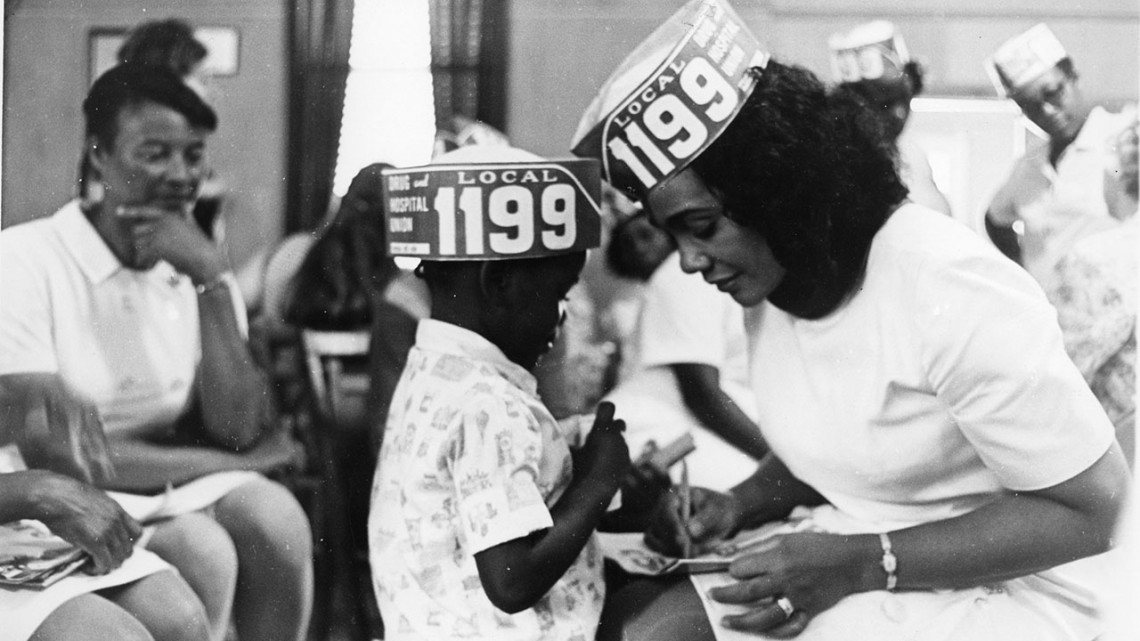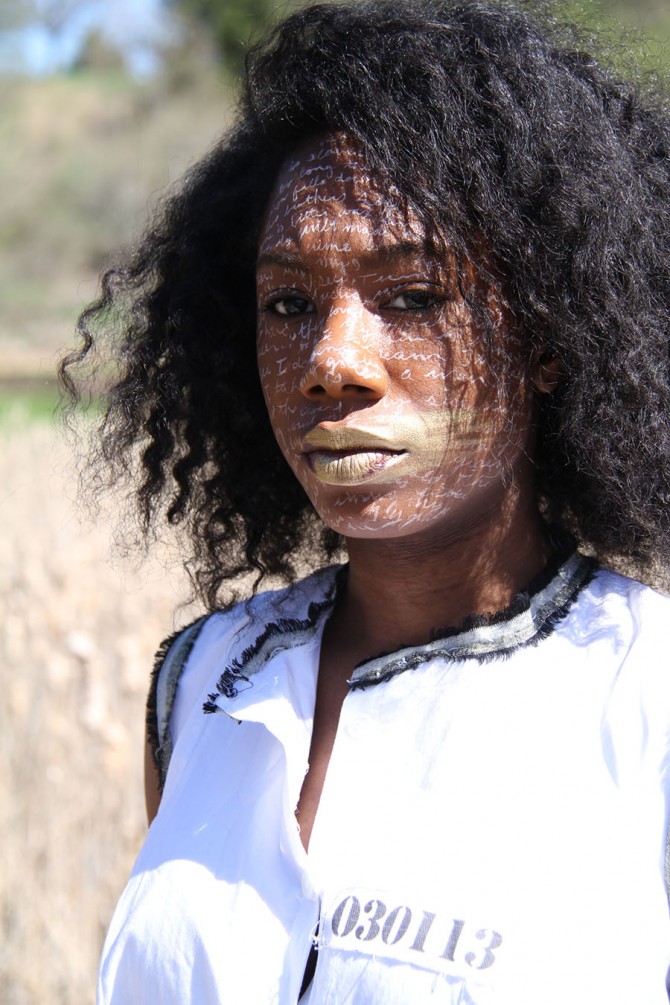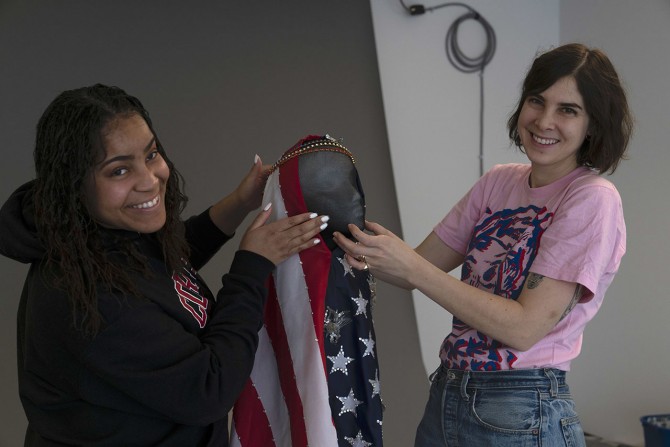
Coretta Scott King wears a local 1199 union cap during the 1969 “Union Power, Soul Power” campaign, where she served as honorary chair and advocated for health care workers’ rights on the picket line in Charleston, South Carolina. Two of the caps, both on loan from the Kheel Center, will be displayed as part of “Women Empowered: Fashions From the Frontline.”
Exhibit chronicles women’s empowerment through fashion
By Daniel Aloi
From articles of clothing worn by suffragettes, a circus trapeze artist’s outfit and a WWII Naval Reserve uniform to shoes worn during a winning Congressional campaign in the 2018 midterm elections, prominent women and everyday unsung heroes are featured in a new exhibition opening Dec. 6 at Cornell in the display cases on Level T of the Human Ecology Building.
Accomplished Cornellians are among the pacesetting artists, athletes, politicians, entertainers, activists and academics represented in “Women Empowered: Fashions From the Frontline.” A public opening reception will be held Thursday, Dec. 6, 5 to 7 p.m. in the College of Human Ecology Commons.
Chronicling how women have strategically used fashion to empower and collectively uplift themselves, the exhibition is part of the 2018 Cornell Council for the Arts Biennial and explores the Biennial theme of “Duration: Passage, Persistence, Survival” through fashion objects. It was curated by students in fiber science and apparel design.
“Fashion is a highly visible and forceful medium that commands attention and communicates possibilities,” said Denise Green, assistant professor of fiber science and apparel design, faculty adviser on the exhibition project.
Graduate student in apparel design Rachel Getman said, “I think it’s exciting to see how the understanding of feminism is really expanding. For women in the past, in different waves of feminism, there’s been stigma attached to being a feminist.”
Today, there is an inclusivity and recognition of women as equals that is “allowing people to be aligned with the movement,” she said.
“With that inclusion comes fashion,” Green added. “I think fashion has often been stigmatized as frivolous and antithetical to feminism; this exhibition is showing the opposite – that women throughout history have strategically and persistently used fashion to make statements [that are] political, social and aesthetic.”
“We’re challenging stereotypes of what feminism can be,” she said.
Items on display will include two decorative collars that have defined the personal style of Supreme Court Justice Ruth Bader Ginsburg ’54; a skirt suit worn by former U.S. Attorney General Janet Reno ’60; and the gown College of Human Ecology co-founder Martha Van Rensselaer wore when she met with the Queen of Belgium after helping that country rebuild its libraries following WWI.
“There are feminists that are very modest and some that are not,” said Lynda May Xepoleas, a graduate student in apparel design. Her research for the exhibit included interviewing Regina “Reggie” Baker Robbins ’75 and Penney Mapes Cook ’75, who repurposed men’s uniforms when they helped start the first women’s ice hockey team at Cornell.
Contemporary designs in the exhibit include a hockey jersey signed by four Cornell women who propelled Canada to a gold medal in the 2014 Winter Olympics; an American flag hijab by Haute Hijab creative director Gizelle Begler ’08, inspired by a 2016 image by artist Shepard Fairey; and an original design by Rachel Powell ’17 that engages with the #MeToo movement and addresses rape culture.
“When you’re on the front line there are traumas, too – experiences that can be expressed through fashion,” Green said.
Earlier this fall, the student co-curators requested the tattered shoes Alexandria Ocasio-Cortez wore during her campaign for Congress in New York’s 14th District. Part of a large movement of women inspired to run for office, Ocasio-Cortez is, at 29, the youngest woman ever elected to the U.S. House of Representatives.
The curators wanted to show diversity: “every race, every ethnicity, every background,” said graduate student Jessica Guadalupe Estrada. For example, having something worn by Ocasio-Cortez, she said, is “a good demonstration of that fearlessness of what women want to show through their clothing. We’re looking at womankind and empowerment in a different way.”
Women achieving firsts is a major thread here, in artifacts including a small quilt made by Liberian seamstresses with commemorative cloth depicting President Ellen Johnson Sirleaf, Africa’s first female head of state. Motherhood also is a theme, with suits worn by the first female governor of Texas, Ann Richards, at her inauguration and by her daughter, Cecile Richards, when she testified before Congress as president of Planned Parenthood in 2015.
Everyday women are an important part of the narrative, with political T-shirts, Pussyhats and other emblematic items worn by women to convey solidarity and collective empowerment. There’s a Local 1199 cap from the “Union Power, Soul Power” campaign for health care workers’ rights in 1969, led by Coretta Scott King; items worn by suffragettes in the early 20th century; and a gown worn in the 1880s by early advocate of women’s suffrage Olivia Langdon, a local woman wed to writer Samuel L. Clemens (Mark Twain).
Estrada said the exhibition “exposes how fashion is a form of protest. I think people underestimate clothing. Even if women don’t see it when they’re wearing it, what they’re wearing says a lot.”
Some of the items are on loan from the Texas Fashion Collection, the Hockey Hall of Fame, the Western Reserve Historical Society and private collections, and others are held in Cornell collections – the Human Sexuality Collection, the Kheel Center for Labor Management Documentation and Archives, the Division of Rare and Manuscript Collections, and the Cornell Costume and Textile Collection.
“Women Empowered” will be on display in the Human Ecology Building through March 31, 2019.
Media Contact
Get Cornell news delivered right to your inbox.
Subscribe



